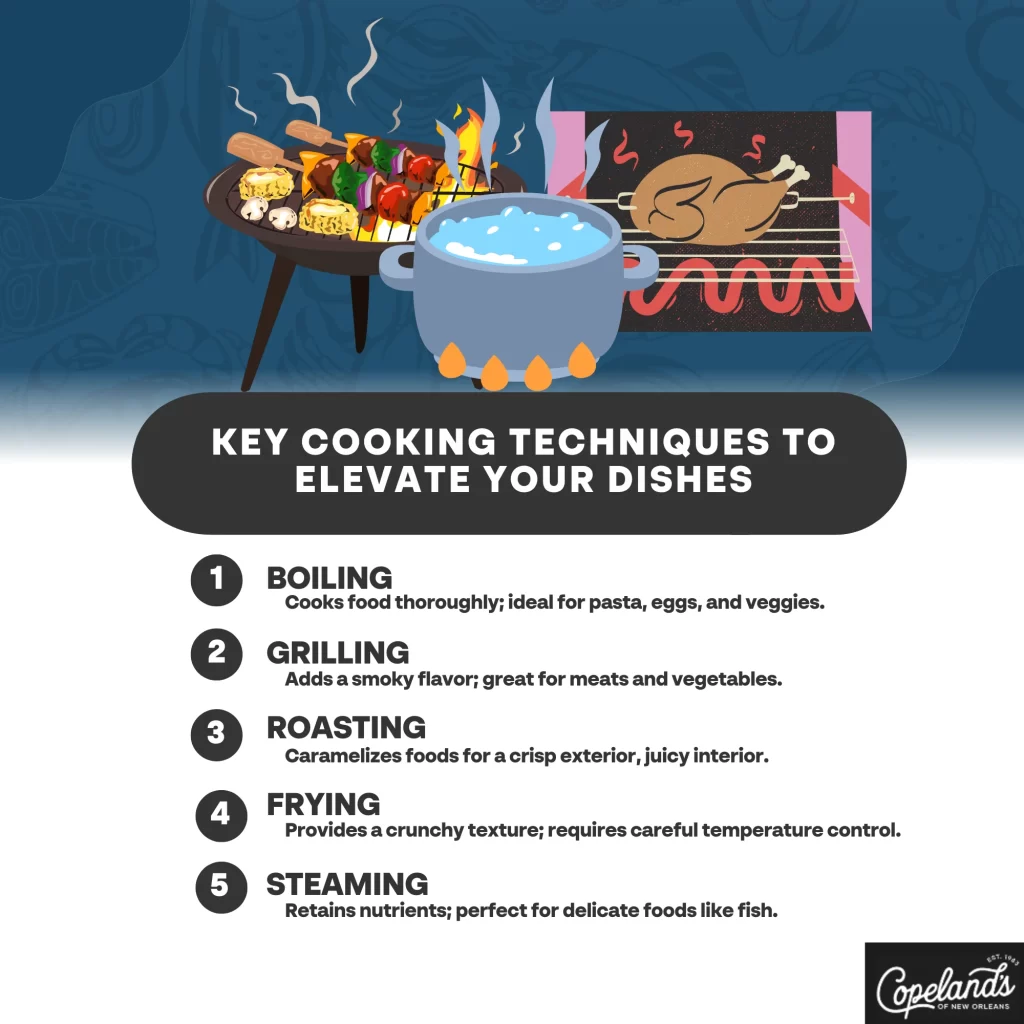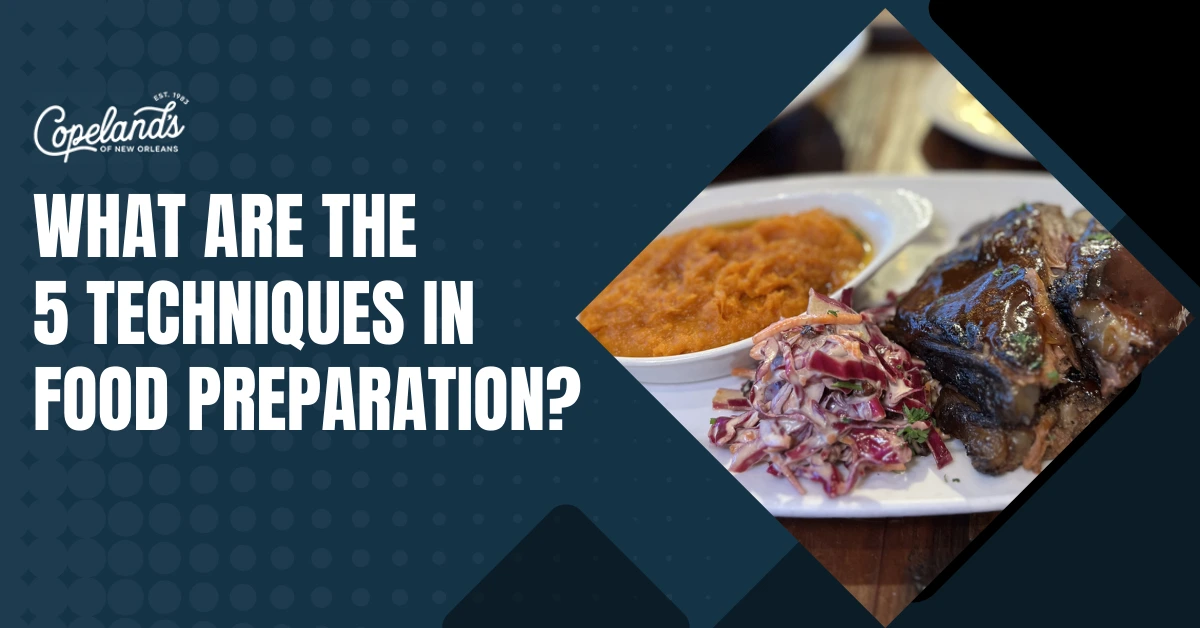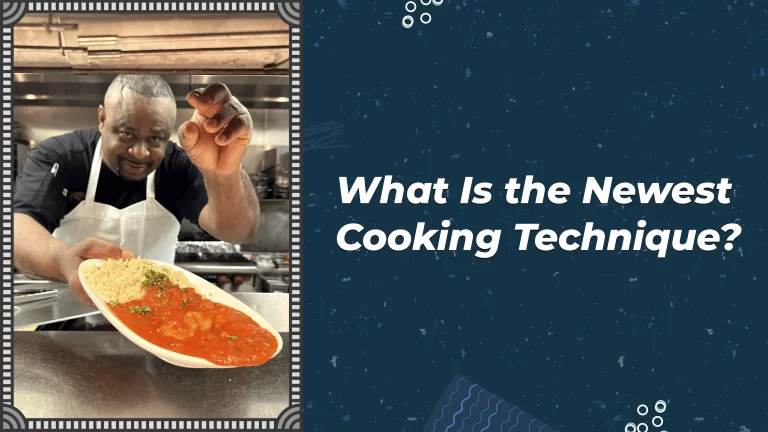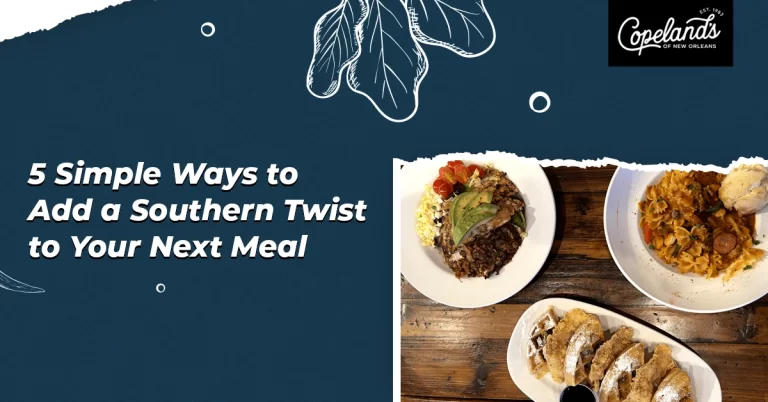In your culinary journey, you’ll encounter five essential techniques in food preparation: boiling, grilling, roasting, frying, and steaming. Boiling is your go-to for thorough cooking and flavor enhancement, while grilling imbues a desirable smoky flavor. Roasting employs high-temperature dry heat, bringing out natural flavors and frying delivers that crave-worthy crunch. Finally, steaming preserves both nutritional value and natural flavors. Master these techniques for a balanced and innovative approach to your meals. Remember, there’s always more to unravel in the art of food preparation, with each new technique potentially leading you to your next kitchen masterpiece.

Key Takeaways
- Boiling is a basic cooking method often used for cooking vegetables, pasta, and eggs in hot water.
- Grilling is a technique that uses high heat to add a smoky flavor to food, often used for meats and vegetables.
- Roasting utilizes high temperatures in an oven to create caramelized, juicy dishes, ideal for meats and vegetables.
- Frying involves cooking food in oil to achieve a unique crunch and rich flavor, requiring careful temperature control.
- Steaming is a health-conscious technique that preserves the color, texture, and nutritional value of food.
What is food preparation?
Plunging into the culinary world, food preparation is an integral part of the cooking process. It’s more than just chopping onions or peeling potatoes. It’s an art form, a skill that involves intricate procedures and innovative techniques. You might think it’s all about just getting your food ready for cooking, but it’s so much more.
Consider this: understanding and implementing food preparation techniques that result in more healthful and nutritious meals can make a significant difference to your overall diet. It’s not just about cooking; it’s about crafting meals that aren’t only tasty but also good for you.
Imagine using techniques such as blanching to preserve the vibrant colors and essential nutrients in your vegetables. Or consider the process of marinating, which can infuse your proteins with flavor while also tenderizing them. What about soaking grains and legumes, a simple practice that can enhance digestibility and nutrient absorption?
Each technique you use contributes to the final outcome of your dish, impacting its flavor, aroma, texture, and nutritional profile. It’s these details that elevate your food from good to great.
What are the 5 methods of food preparation?
You’ve likely used a variety of techniques in your kitchen, but have you ever stopped to contemplate the five main methods of food preparation?
Boiling, grilling, roasting, frying, and steaming each offer unique ways to transform raw ingredients into delicious meals.
Let’s explore how these techniques enhance flavor, texture, and appearance, and how you can use them to take your culinary skills to the next level.
1. Boiling
New Orleans Scratch Kitchen’s mastery of boiling, one of the five key methods of food preparation, truly sets it apart. When you think about boiling, you might envision a simple pot of water on the stove. But here, it’s more than that. It’s an art form. It’s about understanding the right temperature, timing, and the perfect blend of spices.
Food preparation methods include boiling, which is an essential and versatile technique in any kitchen. It’s a foolproof method to cook food thoroughly, but it’s also where the innovation comes in. You see, at New Orleans Scratch Kitchen, they don’t just boil, they season the water with a unique blend of aromatic herbs and spices, infusing the food with a depth of flavor that’s hard to beat.
Whether it’s the succulent shrimp in their famous Creole dishes or the hearty potatoes in their comforting soups, boiling is a fundamental technique that contributes greatly to the unique taste of their offerings.
2. Grilling
Imagine firing up a grill, the aroma of smoky char filling the air. You’re about to dive deep into one of the most primal techniques in food preparation—grilling. This method is all about heat, timing, and a bit of skilled intuition.
Grilling isn’t just about slapping a steak on the metal grates and waiting. It’s about understanding the nuances of heat control, the significance of proper marination, and the art of turning and flipping. Different types of food require different grilling techniques.
Meats, for instance, need high, direct heat to sear their surfaces and keep their insides juicy. Vegetables, on the other hand, do better with indirect, medium heat to avoid charring.
It’s also essential to know when to close the lid. Covering your grill traps heat, creating an oven-like environment perfect for cooking thicker cuts of meat. Leaving it open, conversely, gives you a crispy exterior on thinner cuts or veggies.
Grilling, like all cooking techniques, is a balance of science and art. It’s an exploration of flavors, a dance of heat and timing. With practice, you’ll master this technique, transforming simple ingredients into smoky, flavorful delights.
3. Roasting
While grilling often steals the spotlight in outdoor cooking, let’s shift our focus to another timeless method—roasting. As one of the five key food preparation methods, roasting might strike you as simple, but it’s where the magic happens. You’re fundamentally using dry heat to cook food, often in an oven.
But it’s not just about blasting your meal with high temperatures. Roasting requires careful control over heat and time. You’ve got to strike a balance between the two to achieve a dish that’s perfectly cooked all the way through, yet boasts a beautifully caramelized exterior.
It’s innovative, in its own traditional way. Think about a roast chicken, its skin crispy and golden, while the meat inside remains moist and succulent.
Roasting also brings out the natural flavors in your food. It’s a technique that doesn’t need much seasoning or fancy additions—it lets the food speak for itself.
4. Frying
Often, you may find yourself resorting to frying, another essential method in food preparation. This food technique is renowned for its ability to deliver a unique, tantalizing crunch and rich flavor to food items, making it a favorite worldwide.
Frying isn’t just about dunking food into a deep pot of hot oil. It’s a delicate balance of temperature control, oil selection, and timing. You’ve got to guarantee the oil is sufficiently heated, but not smoking. It’s a common misconception that the hotter the oil, the better. In reality, excessively hot oil can cause food to burn on the outside while remaining raw on the inside.
Also, the choice of oil matters. Different oils have varying smoke points, and ideally, you’d want one with a high smoke point like canola or peanut oil for frying. They’re less likely to create an off flavor and can withstand high temperatures.
Moreover, don’t overcrowd the pan. It drops the oil’s temperature drastically, leading to soggy, oily food. Strategically spacing out the food allows it to cook evenly and achieve that satisfying crunch.
5. Steaming
Steaming, from the inside out, transforms your ingredients into a culinary masterpiece. This technique, one of the five primary preparation techniques for cooking, preserves your food’s color, texture, and most importantly, its nutritional value.
As you steam, you’ll find it’s an innovative method that’s not only healthier but also surprisingly versatile. Imagine preparing dim sum, vegetables, or even delicate fish with this method. You’re not drowning the ingredients in water or oil, so they retain their natural flavor. Your food doesn’t lose its vitamins and minerals into the cooking water, which often happens with boiling. Instead, you’re coaxing out their best qualities with steam’s gentle heat.
Steaming also gives you control. You can’t overcook your food as easily as you can with roasting or frying. And you’ll find that it’s a forgiving method, great for beginners and experienced cooks alike.
Incorporate steaming into your cooking routine and you’ll create dishes that are vibrant, tasty, and nutritious. It’s a preparation technique that’s easy, quick, and in line with today’s health-conscious trends. Master the art of steaming and you’ll elevate your culinary skills to a whole new level.
Food preparation techniques
Let’s turn our attention to the art and science of food preparation techniques.
From chopping to sautéing, each method plays an essential role in revealing flavors and textures in your culinary creations.
Then there’s the hardware – the common kitchen equipment used in food businesses, each piece as important as the next in creating mouthwatering dishes.
Food preparation methods
Mastering the art of food preparation is a journey that begins with understanding the basic techniques.
As you explore deeper into this culinary world, you’ll realize that there are numerous techniques for cooking, each offering unique flavors and textures to your dishes.
- Boiling: This method involves cooking food in hot water. It’s commonly used for vegetables, pasta, and eggs.
It’s a simple yet effective way to prepare food, preserving nutrients and enhancing flavors.
- Grilling: Nothing beats the smoky flavor of grilled food.
Whether it’s meat, vegetables, or seafood, grilling imparts a unique, charred taste that’s hard to resist.
- Roasting: This technique involves cooking food in an oven at high temperatures.
It’s ideal for meats and vegetables, resulting in a crispy exterior and juicy interior.
- Sauteing: This method requires cooking food quickly in a small amount of oil or butter.
It’s best for tender foods like onions, peppers, and mushrooms.
Common food preparation equipment for food businesses
While honing your culinary skills through techniques like boiling, grilling, roasting, and sauteing is a great start, it’s equally important to familiarize yourself with common food preparation equipment.
Consider the humble chef’s knife, a cornerstone in any kitchen. It’s not just about having one; you should know the different types, their functions, and how to maintain them. From dicing vegetables to deboning chicken, the right knife can make all the difference.
Similarly, food processors are versatile, reducing manual labor and saving time. Whether you’re kneading dough or grinding nuts, it’s a tool you’ll come to appreciate.
Then there’s the immersion blender, a real game-changer in refining food preparation techniques. Creating smooth soups, emulsifying sauces, or whipping up a quick smoothie, it’s a tool that offers convenience and precision.
Lastly, don’t forget about the importance of good-quality pots and pans. Non-stick, cast iron, stainless steel – each serves a purpose and impacts your cooking results.
Frequently Asked Questions
What Are Some Basic Kitchen Utensils Necessary for Food Preparation?
You’ll need a good chef’s knife, cutting board, mixing bowls, measuring spoons and cups. Don’t forget a spatula, whisk, and a set of tongs. Finally, a grater and a peeler are handy additions.
How Does Food Preparation Impact the Nutritional Value of Food?
You’re always wondering, right? Well, food preparation can greatly affect nutritional value. Overcooking can deplete nutrients, while methods like steaming can preserve them. So, it’s not just what you eat, but how you prepare it.
Are There Any Food Safety Guidelines to Follow During Food Preparation?
Yes, during food preparation, you’re expected to follow certain safety guidelines. Always wash your hands and surfaces, separate raw and cooked foods, cook at safe temperatures, and refrigerate promptly. These practices prevent foodborne illnesses.
What Are Common Mistakes to Avoid in Food Preparation?
You should avoid undercooking or overcooking food, cross-contamination, not tasting as you go, and improper food storage. It’s essential to maintain cleanliness and understand your recipe well to prevent these common food preparation mistakes.
How Can I Improve My Food Preparation Skills?
You can improve your food prep skills by practicing regularly, experimenting with different ingredients and recipes, and learning from your mistakes. Don’t be afraid to try new techniques and always maintain cleanliness in your kitchen.
Conclusion
So, you’ve learned the culinary dance of boiling, grilling, frying, roasting, and steaming. Like a conductor leading a symphony, you now possess the ability to create a harmonic feast from simple ingredients. These techniques are your keys to access an ocean of flavors. Don’t be shy, experiment, and you’ll soon be creating masterpieces in your own kitchen. After all, it’s not just food preparation, it’s an art form. So, ready to cook up a storm?




